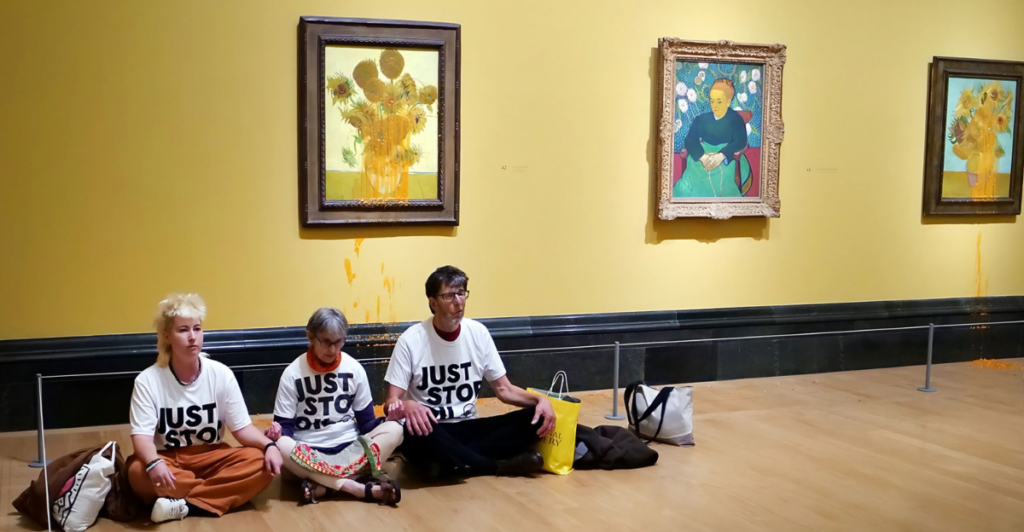
Just Stop Oil is a climate activist group that made headlines—it became a media darling and a villain—by staging disruptive protests like throwing soup at famous works of art and occupying motorways. Love them or hate them, they were impossible to ignore.
But after three tumultuous years, the group is hanging up their fluorescent vests for good. Not because they were tired (or hungry), but because fresh police legislation has made many protests impossible.
Their last meeting? A farewell party-rally: half party, half protest. But beneath the latest festive mood lies a deeper feeling and story: what happens when these kinds of passionate movements get pulled down?
The Rise of Just Stop Oil

In 2022, Just Stop Oil (JSO) didn’t hesitate to become Britain’s most divisive activist group. Their methods were easy but dramatic—painting, road-blocking, and sticking themselves to buildings.
Their target? To call for the suspension of new oil and gas licenses by the UK government. In a single night, they became the loudest voice of the climate movement, triggering shrill condemnation and begrudging admiration.
Art enthusiasts winced. Motorists raged. But JSO remained resolute: anarchy needed to shake awake a world blindly careening towards climate disaster.
When the Paint Dried: Public Backlash

Despite their good works being literally covered in paint splatters, JSO did not exactly win over hearts and minds. Public fury boiled over as protests jammed up commuters, destroyed cultural events, and disrupted daily life.
Only 17% of individuals had a positive view of the group, polls indicated. Even within the ranks of environmental activists, there were worries that JSO’s tactics were suicidal.
Rather than organizing the public, they threatened to terrify the public on whose behalf they were intervening. But JSO was adamant nonetheless: no disruption, no debate.
The Legal Crackdown Begins

Politicians and police weren’t merely observing—police were taking action. The Police, Crime, Sentencing and Courts Act (2022) made it a crime to cause “serious annoyance” or “serious inconvenience.”
And then the Public Order Act (2023) crossed a further line, criminalizing things like “locking on” or obstructing vital infrastructure. Even planning a protest would now get you imprisoned.
Courts also became heavily involved, removing the right of activists to argue their actions were justified out of concern about the climate. Suddenly, activism was extremely dangerous—and extremely costly.
JSO’s Last Protest: A Happy Farewell

On a Saturday in Central London, dozens of activists wore their orange vests for the final time. But unlike previous chaotic protests, this one was a celebration, not a chaotic march. Co-founder Sarah Lunnon called it a bittersweet occasion.
Publicly, JSO claimed victory, saying that government policy had finally caught up with their initial demands. Privately, however, the majority admitted the truth: the legal environment made it nearly impossible for organizations like theirs to exist.
Underground Movements: A New Phase

Without access to traditional protest routes, some activists are evolving. Organizations such as Shut the System (STS) prefer to take undercover action: breaking windows, attacking corporate headquarters, disrupting communication cables.
Unlike JSO, they don’t linger to be arrested. Their defense is that if nonviolent civil disobedience lands one in prison for years, then more secretive tactics are the only remaining tactic. Whether this change results in more disruption—or more isolation—will be seen.
Legal but Loud: Citizen’s Arrest Network

Not everyone is willing to go rogue. The Citizen’s Arrest Network (CAN) found a legal way to resist. Employing very outdated citizen’s arrest laws, they openly “arrest” corporate executives they claim harm the environment.
Rather than shattering windows, they drop thick reports of charges. It’s a strategy that employs the very legal tools that disassembled JSO to prosecute polluters. Organizers claim it as evidence that even angry citizens can discover innovative, legal means of raising hell.
Lessons from the Pink Boat

Earlier climate protests show a different pattern. When in 2019 Extinction Rebellion (XR) occupied Oxford Circus with a massive pink boat, they triggered a riot, but also invited debate.
Rather than mass arrest, they arranged meetings with ministerial officials. Within months, the UK pledged Net Zero by 2050. Times have changed, though. Even MPs who once socialized with protesters now condemn organizations like JSO for alienating the public. The lesson? Timing, public mood, and strategy all count.
Where Public Opinion Stands Now

Despite frustration with agitating protests, public concern about the planet endures. 80% of Britons demanded in a 2023 survey that the government prioritize climate action. But movements like JSO must grapple with an ugly truth: you can’t win over the hearts of the public by annoying them.
Activists are now presented with the dilemma: how to mobilize immediate climate action without driving the public away. There isn’t an easy solution—and no willing leader anxious to step forward and lead, yet.
The End or the Beginning?

As JSO recedes into the past, the future of climate action is uncertain. Will frustration be followed by violence and more sinister, back-room politics? Or will new, more powerful tactics become available that can mobilize hearts without bringing chaos?
One thing’s sure—climate change isn’t disappearing. And neither, probably, is the urge to combat it. Whether that struggle is waged in a courtroom showdown, a clandestine sabotage, or some other orange-vested rebellion remains to be seen: only time—and pressure—will tell.
Explore more of our trending stories and hit Follow to keep them coming to your feed!

Don’t miss out on more stories like this! Hit the Follow button at the top of this article to stay updated with the latest news. Share your thoughts in the comments—we’d love to hear from you!







